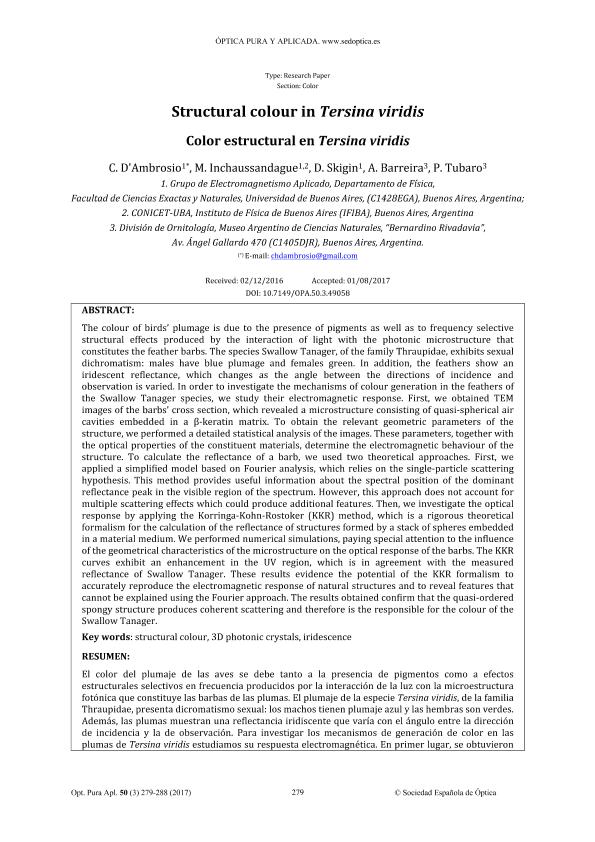Artículo
Structural colour in Tersina viridis
D'ambrosio, Christian Nahuel; Inchaussandague, Marina Elizabeth ; Skigin, Diana Carina
; Skigin, Diana Carina ; Barreira, Ana Soledad
; Barreira, Ana Soledad ; Tubaro, Pablo Luis
; Tubaro, Pablo Luis
 ; Skigin, Diana Carina
; Skigin, Diana Carina ; Barreira, Ana Soledad
; Barreira, Ana Soledad ; Tubaro, Pablo Luis
; Tubaro, Pablo Luis
Fecha de publicación:
10/2017
Editorial:
Sociedad Espanola de Optica
Revista:
Optica Pura y Aplicada
ISSN:
2171-8814
Idioma:
Inglés
Tipo de recurso:
Artículo publicado
Clasificación temática:
Resumen
The colour of birds' plumage is due to the presence of pigments as well as to frequency selective structural effects produced by the interaction of light with the photonic microstructure that constitutes the feather barbs. The species Swallow Tanager, of the family Thraupidae, exhibits sexual dichromatism: males have blue plumage and females green. In addition, the feathers show an iridescent reflectance, which changes as the angle between the directions of incidence and observation is varied. In order to investigate the mechanisms of colour generation in the feathers of the Swallow Tanager species, we study their electromagnetic response. First, we obtained TEM images of the barbs' cross section, which revealed a microstructure consisting of quasi-spherical air cavities embedded in a ß-keratin matrix. To obtain the relevant geometric parameters of the structure, we performed a detailed statistical analysis of the images. These parameters, together with the optical properties of the constituent materials, determine the electromagnetic behaviour of the structure. To calculate the reflectance of a barb, we used two theoretical approaches. First, we applied a simplified model based on Fourier analysis, which relies on the single-particle scattering hypothesis. This method provides useful information about the spectral position of the dominant reflectance peak in the visible region of the spectrum. However, this approach does not account for multiple scattering effects which could produce additional features. Then, we investigate the optical response by applying the Korringa-Kohn-Rostoker (KKR) method, which is a rigorous theoretical formalism for the calculation of the reflectance of structures formed by a stack of spheres embedded in a material medium. We performed numerical simulations, paying special attention to the influence of the geometrical characteristics of the microstructure on the optical response of the barbs. The KKR curves exhibit an enhancement in the UV region, which is in agreement with the measured reflectance of Swallow Tanager. These results evidence the potential of the KKR formalism to accurately reproduce the electromagnetic response of natural structures and to reveal features that cannot be explained using the Fourier approach. The results obtained confirm that the quasi-ordered spongy structure produces coherent scattering and therefore is the responsible for the colour of the Swallow Tanager.
Palabras clave:
3d Photonic Crystals
,
Iridescence
,
Structural Colour
Archivos asociados
Licencia
Identificadores
Colecciones
Articulos(IFIBA)
Articulos de INST.DE FISICA DE BUENOS AIRES
Articulos de INST.DE FISICA DE BUENOS AIRES
Articulos(MACNBR)
Articulos de MUSEO ARG.DE CS.NAT "BERNARDINO RIVADAVIA"
Articulos de MUSEO ARG.DE CS.NAT "BERNARDINO RIVADAVIA"
Citación
D'ambrosio, Christian Nahuel; Inchaussandague, Marina Elizabeth; Skigin, Diana Carina; Barreira, Ana Soledad; Tubaro, Pablo Luis; Structural colour in Tersina viridis; Sociedad Espanola de Optica; Optica Pura y Aplicada; 50; 3; 10-2017; 279-288
Compartir
Altmétricas



